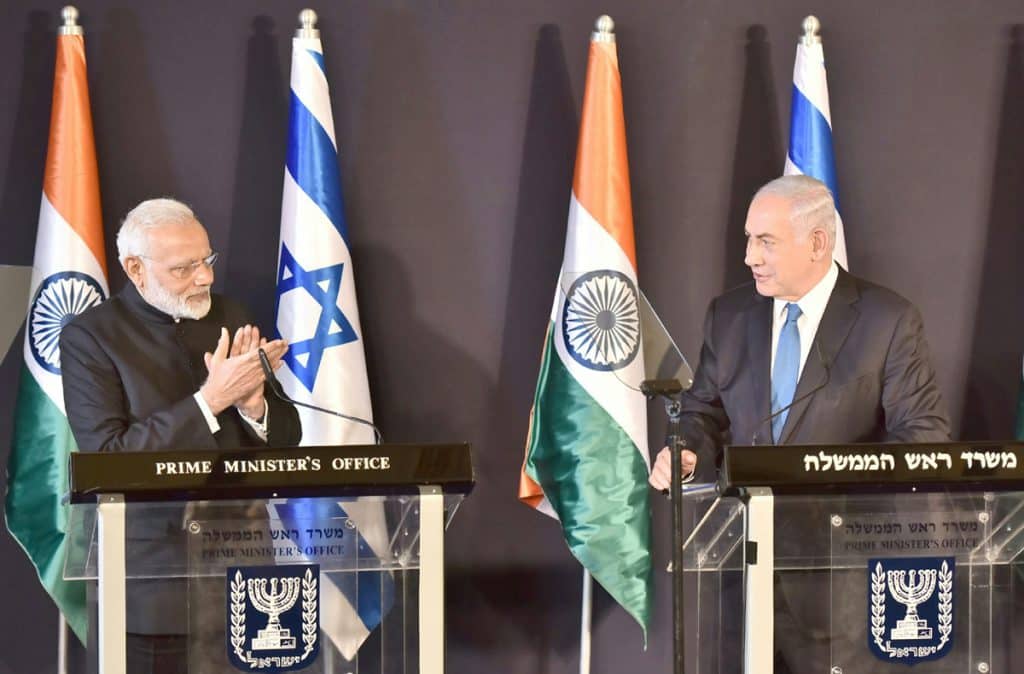
The following essay is not intended to be a comprehensive tour d’horizon of the post-independence evolution of the relations between Israel and India, nor even of the overall scope of defense ties that have developed so rapidly since the early 1990s. Rather, it has a narrower focus: The importance that the maritime theater—i.e. the Indian Ocean and its adjacent waters—has for both countries and the scope of cooperation and potential benefits that could accrue to both from close collaboration in this sphere.
However, some deference to the wider general context cannot be totally avoided.
From a chilly past to a cordial present
Just over a month after the October 7 atrocity, the Washington Post ran an article illustrating the remarkable metamorphosis that has emerged in Indo-Israeli relations over the previous three decades.
Headlined India’s Mideast rethink, it noted: “With war raging in Gaza, India’s embrace of Israel’s security concerns has underscored how dramatically the relationship between the two countries has developed since its chilly beginning…”.
Underlining these frosting beginnings of the bilateral ties, it wrote: For most of independent India’s history, New Delhi had no diplomatic relations with Israel. Just over 40 years ago, India even issued a postage stamp depicting the Indian and Palestinian flags flying side by side and the words “Solidarity with the Palestinian people.”
By contrast, today: “Today, Indian and Israeli flags are displayed together at rallies demonstrating solidarity with Israel after Hamas’s Oct. 7 attack. The two countries have developed significant military ties…[Prime Minister]Modi immediately condemned the Hamas attack and later reiterated that the “people of India stand firmly with Israel in this difficult hour.”
The change in the ties between the two countries has indeed been remarkable and over the last two decades, I have written extensively on the strategic rationale for strong ties between a resurgent India and the Jewish state—ties I once dubbed as the bond between the world’s largest democracy and the world’s most beleaguered one.
I identified the areas that, to me, seemed particularly amenable for future (and today, ongoing, cooperation) from agriculture, via water management and rural development to hi-tech and defense collaboration. There was one specific sphere —then rarely discussed—that I raised repeatedly, that of naval cooperation in the Indian Ocean.
The marine theatre: Predicting future trends
Back in 1999, in a policy paper on Indo-Israeli Strategic Cooperation, I wrote that “Indo-Israeli naval cooperation in the Indian Ocean geared toward the development of a logistic infrastructure that would facilitate sea-borne second strike capability…” is a field that should be given “serious consideration”. Elsewhere, in the same paper, I reiterated this, proposing: “Spheres which, prima facie, appear particularly amenable for bilateral collaboration between India and Israel and worthy of decisive US support, include activities such as Indo-Israeli naval activity” involving “development of effective second-strike capabilities (particularly sea- and submarine-borne)”.
Almost a decade later (2008), I once again underscored the need and the potential of such bilateral cooperation: “Co-operation in the naval sphere offers particularly intriguing possibilities which could serve both India’s declared aim to develop a blue-water navy and Israel’s increasingly challenging geo-strategic needs. Given its minuscule territorial dimensions, especially after recent withdrawals in its vain quest for peace, Israel is being compelled to turn to the marine theatre for strategic depth allowing dispersal of weapons systems for second strike capability.”
It is thus gratifying to see the growing acceptance of this perspective and its ongoing application on an ever-widening scale—not only by Israelis, but by senior Indian military figures as well.
Shared strategic & security threats
Thus, in 2011, in an article headlined India and Israel Boost Naval Ties, Lt General (Retd) Naresh Chand wrote: “India shares some common strategic and security threats with Israel and its desire to get closer to the US has also helped in moving the ties forward”. Among these “common interests”, he mentions “the growing interest of the two states in the Indian Ocean”.
Several years later (2016), Rear Admiral Sushil Ramsay (Retd), in a piece entitled –Indo-Israel Defence Co-operation – Naval Perspective, wrote: “The military business between the two nations has flourished to multi-billion dollar enterprise, giving rise to not just wide ranging acquisitions but several successful state-of-the-art joint ventures on munitions, military hardware, core systems”. Underscoring the extraordinary speed at which the bilateral ties had developed, he observed: “As a result of the growing bilateral relations between the two countries over the past two decades, India has emerged as the largest buyer of Israeli military hardware, equipment and consequently Israel has leapfrogged to being the second-largest defence supplier to India after Russia.”
Significantly, some sources have estimated that in some years, Israel has even surpassed Russia as India’s leading arms supplier[1]. A substantial portion of this burgeoning trade has included billion-dollar contracts for the supply of missiles and radar systems for the Indian Navy’s destroyers and corvettes[2].
Tracing the course of the evolution of the Indo-Israel nexus, a Time magazine article, How India Became Pro-Israel comments: “In recent years, India has purchased about $2 billion worth of weapons annually from Israel. India has bought missiles, drones, bombs, and border-security equipment, and is now the Israeli defense industry’s biggest foreign customer.”
The emerging strategic stature of the Israeli navy
To be sure the list of armaments supplied by Israel to India, or developed with India on the basis of Israeli know-how—including naval-related weapons systems—is long and diverse. But as impressive as the multi-billion catalog might be, I would rather turn the focus less on the technical and more on the conceptual in approaching the discussion of the potential benefits and the pressing need for cooperation between Israel and India.
In this regard, it should be recalled the strategic importance of Israel’s navy has only emerged relatively recently. Indeed for much of the IDF’s history, with the exception of its elite marine commando unit, it was usually considered a service of lesser importance, relative to its ground forces and certainly to its dominant air force. However, in recent years with changes in the nature and capabilities of Israel’s adversaries and the advances in technology, the navy is emerging as a major—indeed, vital—strategic arm for Israel’s defense—particularly regarding the provision of a mobile and elusive platform for second-strike capability in the vast expanses of the ocean, rather than in static locations on dry land.
Indeed, the enhanced status of the Navy can perhaps be gauged by the fact that the most expensive weapons in the entire IDF—new Air Independent Propulsion (AIP) submarines—are designated for its use. According to several sources, the three new vessels on order are priced at a total of almost 3.5 billion dollars[3] a price tag that dwarfs that of the IAF’s much-vaunted F-35, its most sophisticated and costly aircraft.
The same—only more so
The developments in Israel’s strategic milieu in recent years have done nothing to diminish the validity of the arguments I advanced 25 years ago for naval cooperation between India and Israel. To the contrary, with time, the arguments for such collaboration have only been thrown into sharper relief.
The implications of Israel’s diminutive geographic size have been exacerbated by the acquisition by its non-state adversaries—Hamas, Palestinian Islamic Jihad, and Hezbollah—of an increasingly menacing array of missiles, rockets, and UAVs, some of them with precision guidance. Virtually all of Israel’s land-based strategic installations are within the range of some form of airborne weaponry. Indeed, this was vividly underscored on April 13, when Iran launched over 300 projectiles at the Jewish state. Although virtually all were intercepted by Israel’s air-defense systems—with some aid from allies—this is no guarantee for the future. Of particular significance is the fact that one of the IAFs largest bases, Nevatim, where three squadrons of the vital F-35 are stationed, was targeted. Although only minor damage was sustained, this again cannot be assumed to be a guarantee for the future. Indeed, one cannot discount the possibility that future attacks may be so intense that they may—at least, partially—overwhelm the air defenses protecting the country, and impair—perhaps even cripple—its ability to retaliate with a devastating second strike launched from static land locations. Indeed, in this regard, it should be recalled that one of the targets in the April 13 attack was the runways at Nevatim air base, which, in fact, were slightly damaged—revealing the focus enemy intentions, and future direction of their efforts.
More so (cont.)
But better, and more abundant, armaments in the hands of old enemies are not the only reason that the marine theater is acquiring growing strategic significance. New adversaries, who had no previous role in the conflict, have entered the battle, endangering both Israeli and Indian interests. These are the Iranian proxies, the Houthis in Yemen who have lately attacked both southern Israel and ships in the waters of the Indian Ocean and the adjoining Red Sea.
The Houthi leadership has already openly proclaimed that their intention is to disrupt international shipping to bring pressure to bear on Israel to halt its military operations against Hamas in Gaza. Indeed in March, the Houthi leaders declared that it was expanding its operations to prevent Israel-linked ships from passing through the Indian Ocean toward the Cape of Good Hope.
As Oshrit Birvadker points out, India too has been adversely impacted by Houthi maritime operations. She notes: “The Houthis’ attacks in the Red Sea since November have slowed commerce between Asia and Europe and roused concern in India’s government.”
Warning that, since much of India’s economy “relies on maritime commerce”, India could lose “tens of billions of dollars this year because of a war far from its borders…[as the] Houthi attacks have forced Indian ships to sail around the Cape of Good Hope instead of using the shorter route between Asia and Europe…through the Suez Canal”.
Significantly, on several different occasions, the Indian navy has responded to distress calls from commercial ships attacked by Houthi missiles, underscoring the shared perils to which both nations are subject.[4]
Beyond the horizon, below the surface
The current military confrontation between the Houthis, supported and guided by Iran, and Israel and the US led international maritime coalition highlights the dangerousness of the threat to global and Israeli freedom of navigation in the Red Sea and the Indian ocean. It clarifies the importance of the strategic alliance between Israel and the US and of the decision to include Israel in the area of responsibility of the US Central Command (CENTCOM). The American fleet in the region is by far the most powerful and Israel should continue to invest in enhancing the cooperation with the US in this context and build together with the US, other democracies (including India) and the pragmatic Arab states a regional naval security regime that would guarantee safe passage in international waters. This is necessary among other reasons, also to enable the implementation of the grand plan of establishing a maritime and ground route of trade from India to Europe through the Arab peninsula, Jordan and Israel.
But at the same time, as the growing polarization of US politics and commensurate anti-Israel sentiment in vocal sectors of the American public underscore the precariousness of Israel’s almost exclusive strategic reliance on the US—see my 2001 “Diversifying Strategic Reliance”, diminishing US strategic support for Israel because of a widening gap in the perceived national interests of Israel and America is a contingency that must be planned for. In this regard, India should be seen as a vital partner in future strategic enterprises—in which the naval sector should play a crucial role. Of course, none of this is intended that India could replace the US as Israel’s major strategic partner—and the proposal here is that it should play the role of an important strategic supplement rather than an overall strategic alternative.
Of course, as a huge sub-continent, with an almost 8000 km shoreline to secure and protect, India’s maritime requirements are very different from those of Israel. These vast differences do not diminish the scope of potential cooperation in numerous strategically relevant spheres, including the naval sphere.
Indeed, India has embarked on an ambitious initiative of naval construction, including nuclear-powered submarines and aircraft carriers. The Indian Navy currently operates both a domestically produced nuclear submarine and two aircraft carriers, with additional vessels under various stages of development and/or commission. (Significantly, India is the only country outside the five permanent members of the UN Security Council to have built a nuclear-powered submarine.)
Reaching for the moon?
Although these projects have not been entirely without hitches, they have facilitated impressive advancement in the capabilities of the Indian navy, which New Delhi increasingly sees as vital in meeting security challenges from Pakistan and strategic challenges from China. Clearly, with its proven technological capabilities, there is little doubt that Israel is in a unique position to make a far-reaching contribution to these endeavors.
With Joe Biden under intense pressure from the “woke’ left wing of his party, and the support for Israel increasingly partisan, the case for forging closer bonds with India, already the world’s fifth-largest economy (and predicted by some to soon be the third) becomes an evermore compelling prospect.
With the differing strengths and weaknesses of the two countries serving to complement/ supplement each other, it is not beyond the realm of feasibility to envisage Israel acquiring the know-how to co-produce its own nuclear submarine fleet to comprise what would, arguably, be the ultimate second-strike capability. Those, who might raise a skeptical eyebrow and scoff dismissively at such ambitious objectives, should recall that Israel has already proven that it has the ability to manufacture a top-class supersonic fighter, launch satellites, produce unrivaled multi-layer missile defense systems…and even reach the moon.
With a GDP significantly of over US 500 billion dollars (well over double that of 2010) and a GDP per capita above that of the UK, Germany, France, Japan, and Italy)—something inconceivable less than two decades ago—things that seem fanciful today should not be dismissed as such, especially if there is a strong security imperative driving it)
In a recent AP News report, Vice Adm. Anil Kumar Chawla, formerly head of India’s southern naval command addressed India’s growing emphasis on its naval forces and the rationale for the Indian Navy’s operations following the previously mentioned Houthi attacks on commercial shipping. “We are not doing it only out of altruism: he asserted, “Unless you are a maritime power you can never aspire to be a global power”.
This, of course, brings the discussion back to the introductory excerpt and the crucial question it embodies: Who will dominate the Indian Ocean, the eastern approaches to Europe, and south and central Asia–powers committed to the preservation of enlightened values of moderation and restraint, or powers committed to fundamentalism and fanaticism, who would impose their regressive values upon their surroundings…and beyond?
In this respect, Indo-Israel naval cooperation can certainly comprise a sturdy bulwark against the menacing rise of these dark forces.
[1] see here: https://www.sps-aviation.com/story/?id=68&h=A-Friend-In-Deed , https://www.inss.org.il/strategic_assessment/israels-arms-sales-to-india , https://www.hindustantimes.com/world-news/israel-likely-to-become-india-s-largest-arms-supplier/story-tZQFenVzYWzaQFnPqbznqM.html
[2] see here: https://thediplomat.com/2018/10/israel-to-supply-missile-defense-systems-to-indias-navy-for-770-million/ , https://swarajyamag.com/defence/explained-the-indian-navy-new-game-changing-radar
[3] see here: https://www.defensenews.com/naval/2022/01/20/israel-inks-34-billion-submarine-deal-with-germany/ , https://www.timesofisrael.com/israel-signs-scandal-ridden-e3-billion-deal-with-germany-to-buy-new-submarines/ , https://www.reuters.com/world/middle-east/israel-signs-34-bln-submarines-deal-with-thyssenkrupp-2022-01-20/
[4] see here: https://www.youtube.com/watch?v=y-M_Ml-WwxY , https://www.youtube.com/watch?v=SXyK5hBjWkI





